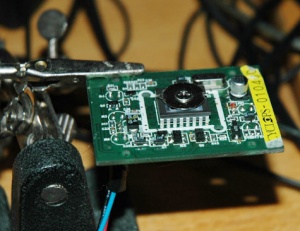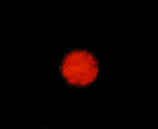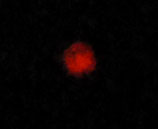Americium 241
Americium 241 emits mainly alpha and gamma radiation. It has a half life of 432.2 years, by emitting alpha particles it turns into neptunium-237.
- Activity
- 3.428 Ci/g
- Average energy of most abundant emission
- Alpha - 5.49 MeV
- Gamma & X-rays - 59.54 keV (Dose rate at 1 m distance (mSv/h*GBq) = 0.085)
| Type | Energy | Percentage |
|---|---|---|
| Alpha | 5.485 MeV | 84.5 % |
| Alpha | 5.443 MeV | 13.0 % |
| Gamma | 59.5 keV | 35.9 % |
| Gamma | 26.3 keV | 2.4 % |
| Gamma | 13.9 keV | 42 % |
Most of the radiation does not travel very far from the sample, the alpha radiation does not pass through more than 3 cm of air and is stopped by almost any solid object. The weaker gamma radiation will pass through some solid objects but at distance of a few metres it is mostly harmless.
At close range the radiation is intense enough to affect electronic devices. Even small samples ionize the air around it, this effect is used in some smoke detectors. The radiation caused a 74HCT14 Schmitt trigger to oscillate at a distance of a couple of centimetres. Most likely this was because the air becoming ionized by the radiation and conducting a weak current from an output pin to an input pin.
Most of the radiation does not travel very far from the sample but at close range it is intense enought to affect electronic devices. Even small samples ionize the air around it, this effect is used in some smoke detectors. The radiation caused a 74HCT14 Schmitt trigger to oscillate at a couple of cm distance. Most likely this was because the air becoming ionized by the radiation and conducting a weak current from an output pin to an input pin.
Contents
Radiation detection with a CCD chip
The reccomended method for detection of radiation from Am-241 is a ZnS scintillation counter but a bare CCD chip works quite well for detecting some types of radiation.
This video shows how the radiation affects a CCD imaging chip covered with a glass plate. Since the glass will stop all the alpha radiation only the gamma and beta radiation hits the CCD surface. Hot pixels show up at random moments. This would be suitable as a base for generating true random numbers.
Fluorescence of phosphor
The radiation is capable of exiting phosphors found inside low energy light bulbs. The phosohor light up very dimly with a red colour. It is almost impossible to see with the naked eye. The eye is not capable of determining the colour but a long exposure photograph shows the colour well.
The material that is excited by the radiation is most likely europium-doped yttrium trioxide (Y2O3:Eu) with an emission band at 612 nm. Since the brightness is reduced by over 90% by the 0.015 mm aluminium foil it must be alpha radiation that excites the phosphor since gamma radiation will pass through the foil quite easily.
Americium-241 emits mainly alpha and gamma radiation. It has a half life of 432.2 years, by emitting alpha particles it turns into neptunium-237. The most common source is americium-241 oxide from ionizing household smoke detectors.
Emission spectrum of Americium-241
| Type | Energy | Percentage |
|---|---|---|
| Alpha (α) | 5.485 MeV | 84.5 % |
| Alpha (α) | 5.443 MeV | 13.0 % |
| Beta (β) | 52 keV | Unknown |
| Gamma (γ) | 59.5 keV | 35.9 % |
| Gamma (γ) | 26.3 keV | 2.4 % |
| Gamma (γ) | 13.9 keV | 42 % |
Some beta emission is suspected
Types of radiation
| Type | Nature | Charge | Speed |
|---|---|---|---|
| Alpha (α) | Helium nucleus | +2 | < 0.1 c |
| Beta (β) | Fast moving electron | -1 | < 0.9 c |
| Gamma (γ) | Photon | None | c |
Range and penetrating power of radiation
| Type | Range in air | Thickness of aluminium to halve intensity |
|---|---|---|
| Alpha (α) | Several centimetres | 5 µm |
| Beta (β) | Several metres | 0.5 mm |
| Gamma (γ) | Hundreds of metres | 8 cm |
These values are approximate, the higher the energy the larger the penetrating power
Possible experiments
To find out what kind of radiation you are working with you can filter it with aluminium of different thickness and measure the change in intensity.
Fluorescence
(30s, f/1.4, ISO 1600)
Alpha particles will excite different types of phosphor. If you cover the sample with phosphor or hold the sample close to it a phosphor of the right type will start to glow weakly.
Types of phosphor to use
- Europium-doped yttrium oxide (Y2O3:Eu) - Red
- Silver activated zinc sulphate (ZnS:Ag) - Blue
- Manganese activated zinc sulphate (ZnS:Mn) - Red/Orange
- Copper activated zinc sulphate (ZnS:Cu) - Green
How to view the fluorescence
- Adapt your eyes to the dark by sitting in total darkness for up to 15 minutes. If you then look closely to the side of the light source you can detect flashes of light that contains down to 90 photons and should be able to see a weak glow. If the glow is very weak the eye will not be able to determine the colour of the light and it might just look bluish white.
- Use a loupe or microscope to see single particles excite the phosphor, this is called a spinthariscope.
- Use a digital camera and take long time exposures. A camera makes it simpler to compare different brightnesses and to determine the colour.
Ionization detector
Cloud chamber
CCD chip detector
Safety
Americium-241 oxide as found in household smoke detectors (<35 kBq) is considered safe as long as the sample is not broken up and the dust is inhaled or ingested. Since radiation has a very unpredictable effect on the human body it is safest to treat the sample with respect and store it safely.
Some commercial units can contain 50 times more radioactive material and should be handled with more care. From time to time really dangerous sources can be found and if you don't know exactly what you got you should consider it to be unsafe.


